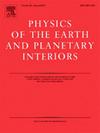Shear wave splitting characteristics of vertically aligned partial melt discs in a subduction zone back-arc setting
IF 1.9
3区 地球科学
Q2 GEOCHEMISTRY & GEOPHYSICS
引用次数: 0
Abstract
Could the strength of observed upper mantle anisotropy in regions of volcanic past be significantly influenced by partial melt inclusions? Patterns of SKS shear wave splitting (SWS), defined via fast polarization direction, ϕ, and delay time, δt, are commonly interpreted in terms of lattice-preferred orientation (LPO) of anisotropic minerals in the upper mantle. However, shape-preferred orientation (SPO) of elastically distinct materials may influence SWS observations as well. We carry out global wavefield simulations using AxiSEM3D to understand the effects of vertically aligned partial melt discs on shear waveforms and derived SWS observations. We confirm earlier findings that the amount of splitting depends, for example, on melt fraction and aspect ratio and demonstrate that the presence of melt SPO (MPO) can significantly increase δt. We explore to what extent a combination with E-type olivine fabric can explain the occurrence of exceptionally high δt in the southern Cascadia Subduction Zone (SCSZ) back-arc and evaluate the effect of dehydration-related fabric transition to A-type on SWS. In this modeling, we assume that the presence of vertical melt disc inclusions is related to continuous upwelling and decompression melting that led to the formation of dykes in the uppermost mantle. For each model we examine the spatial variation and statistical distribution of splitting parameters. For a model considering multiple melt regions, we further evaluate their directional dependence. Stations above the melt inclusions tend to a unimodal δt distribution and explain the high δt values and the wide range of δt observed in the SCSZ back-arc.
Plain language summary
Could mantle deformation caused by volcanic activity be detected by the directional dependence of seismic wave propagation referred to as seismic anisotropy? Shear waves that pass through an anisotropic medium split into two waves with different orientations of wave vibration. These two waves travel at different speeds and accumulate a time delay δt, which can be measured from a seismogram along with the orientation of the faster wave, ϕ. These parameters represent the strength and orientation, respectively, of anisotropy beneath a seismometer. Seismic anisotropy in Earth's upper mantle is often interpreted to be due to the deformation linked alignment of individual grains of olivine, the most common mineral to occur in this depth region. However, the alignment of pockets of partial melt in the upper mantle may also contribute to the observed anisotropy. In this study, we evaluate the potential of vertically aligned partial melt discs to explain unusual previous observations of δt in the southern Cascadia subduction zone, which include exceptionally high delay times with significant variability over small length scales. We computationally simulate the propagation of seismic waves for a variety of models of upper mantle anisotropy that include aligned partial melt and explore the spatial and statistical effects on anisotropy measurements.

俯冲带弧后背景下垂直排列部分熔体盘的横波分裂特征
在过去的火山地区,观测到的上地幔各向异性的强度是否会受到部分熔融包裹体的显著影响?SKS剪切波分裂(SWS)模式,通过快速极化方向,ϕ和延迟时间δt来定义,通常用上地幔各向异性矿物的格优取向(LPO)来解释。然而,弹性不同材料的形状偏好取向(SPO)也可能影响SWS观测。我们使用AxiSEM3D进行了全球波场模拟,以了解垂直排列的部分熔体盘对剪切波形的影响,并推导出SWS观测结果。我们证实了先前的发现,例如,分裂的数量取决于熔体分数和长径比,并证明熔体SPO (MPO)的存在可以显着增加δt。探讨了与e型橄榄石组构的结合在多大程度上解释了南卡斯卡迪亚俯冲带(SCSZ)弧后异常高δt的发生,并评价了脱水相关组构向a型的转变对SWS的影响。在这个模型中,我们假设垂直熔融盘包裹体的存在与导致最上层地幔岩脉形成的持续上升流和减压熔融有关。对于每个模型,我们检查了分裂参数的空间变异和统计分布。对于考虑多个熔体区域的模型,我们进一步评估了它们的方向依赖性。熔体包裹体上方的台站δt呈单峰分布,这解释了SCSZ弧后观测到的高δt值和宽δt范围。由火山活动引起的地幔变形能否通过地震波传播的方向依赖性(即地震各向异性)来检测?横波通过各向异性介质时,会分裂成两个波振动方向不同的波。这两个波以不同的速度传播,并积累了一个时间延迟δt,这可以从地震图和更快的波的方向φ中测量出来。这些参数分别表示地震仪下各向异性的强度和方向。地球上地幔的地震各向异性通常被解释为由于橄榄石单个颗粒的变形相关排列,橄榄石是该深度区域最常见的矿物。然而,上地幔部分熔体袋的排列也可能导致观测到的各向异性。在这项研究中,我们评估了垂直排列的部分熔体盘的潜力,以解释以前在南卡斯卡迪亚俯冲带观测到的异常δt,包括在小长度尺度上异常高的延迟时间和显著的变化。我们计算模拟了多种上地幔各向异性模型的地震波传播,其中包括排列部分熔融,并探讨了各向异性测量的空间和统计效应。
本文章由计算机程序翻译,如有差异,请以英文原文为准。
求助全文
约1分钟内获得全文
求助全文
来源期刊

Physics of the Earth and Planetary Interiors
地学天文-地球化学与地球物理
CiteScore
5.00
自引率
4.30%
发文量
78
审稿时长
18.5 weeks
期刊介绍:
Launched in 1968 to fill the need for an international journal in the field of planetary physics, geodesy and geophysics, Physics of the Earth and Planetary Interiors has now grown to become important reading matter for all geophysicists. It is the only journal to be entirely devoted to the physical and chemical processes of planetary interiors.
Original research papers, review articles, short communications and book reviews are all published on a regular basis; and from time to time special issues of the journal are devoted to the publication of the proceedings of symposia and congresses which the editors feel will be of particular interest to the reader.
 求助内容:
求助内容: 应助结果提醒方式:
应助结果提醒方式:


